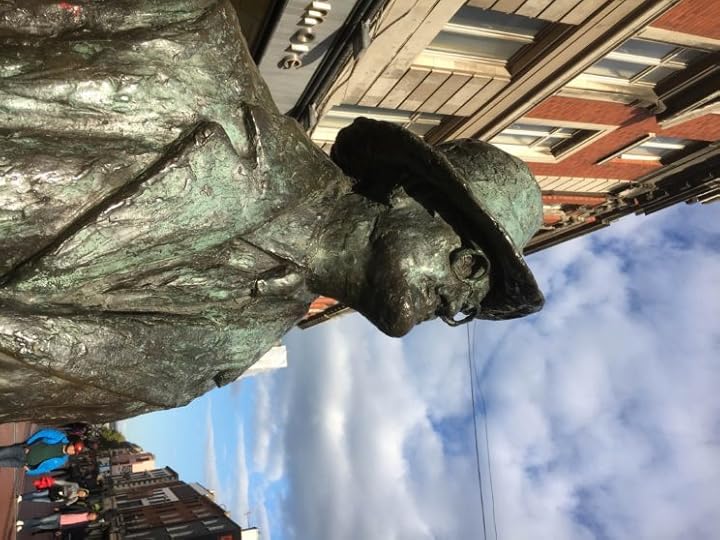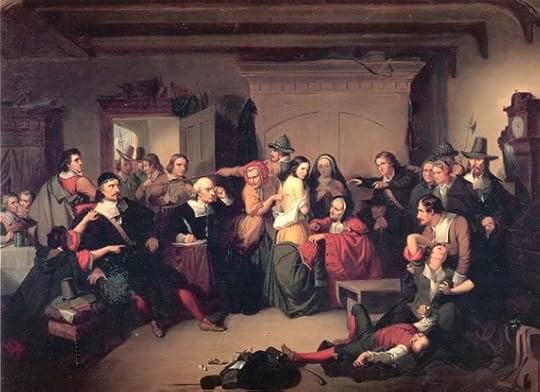Oxford University Press's Blog, page 441
November 15, 2016
Uber drivers found to be ‘workers’ not employees
There has been much in the press recently about the employment tribunal ruling finding that two Uber drivers were not self-employed, but rather workers, and were therefore entitled to some employment rights.
In some reports it has erroneously been suggested that these drivers were found to be employees. This is not what happened. They claimed, and were found to be, workers, which is a different type of employment status, and gives far fewer rights than if they were employees.
What is, then, the difference between employees, workers, and self-employed people? What, if any, impact will this employment tribunal case have on employment law?
There are three main types of what is known as ’employment status’. The first is that of employees. These are people who have an employment contract. It does not have to be a written contract – it can just be an agreement that someone will be employed by the employer. The employee and employer relationship is generally described as one of ‘mutual obligation’ – the employer has to provide work, and the employee has to turn up and do the work if it is provided. The employee has the benefit of the full panoply of employment rights (so long as they have been with the employer for long enough, depending on the right). This includes rights to protection from unfair dismissal and redundancy, which are only available to employees.
The next rung on the employment ladder is that of workers. There are a number of definitions of this, depending on the right being sought, but in summary, it is where a person is not an employee, but agrees to do work personally for someone else, and that person’s clients, rather than being in business on their own account and having their own clients. That is not the exact legal definition, but it sums it up.
However, just because Uber drivers have been found to be workers, that does not necessarily mean that other people who work in the so-called ‘gig’ economy will be in the same position
Essentially, therefore, workers are a kind of independent contractor who have some employment rights. They do not have all the rights of employees, but they do have some, such as holiday pay, working time rights, entitlement to the minimum wage, and protection for whistleblowing.
The third main type of status in employment law is that of self-employed people. These are people who are in business on their own account, and who actively market themselves as an independent person. Such people are not covered by most employment legislation.
The Uber case was decided by the employment tribunal. This is where employment disputes are first determined, and where decisions are made between opposing parties. A decision of the employment tribunal is not binding on other courts or tribunals, and so it does not set a legal precedent. Other tribunals do not have to follow the same decision, although they may find it persuasive.
Therefore although it is significant that a legal tribunal has found, on the particular facts of this case, that these drivers were workers rather than self-employed, this does not currently have any legal effect on other employers. It is simply a decision on those particular drivers and that particular company. It does not currently affect the contractual position of other Uber drivers, unless Uber wanted it to, or if the other drivers decided to bring a case themselves. If they did, then it is likely that any such case would be postponed until the outcome of any appeal. The decision does, however, increase the chances of other people in similar positions bringing cases for workers’ rights.
Uber, who argued that the drivers were self-employed and as such not entitled to any workers’ rights, will almost certainly be appealing to the Employment Appeal Tribunal (‘EAT’). If it does, then any decision of the EAT will be binding on future employment tribunals. If the EAT endorses the decision of the employment tribunal, then this will benefit other Uber drivers who have the same terms as those who brought the original case, but it would depend on the nature of their contracts.
However, just because Uber drivers have been found to be workers, that does not necessarily mean that other people who work in the so-called ‘gig’ economy will be in the same position, as each case depends upon its own facts. If the relationship between drivers, couriers, etc and the business are similar, then such people are likely to be classed as workers and so entitled to some rights. Businesses should therefore take legal advice, but they are not legally obliged to do anything simply as a result of the current employment tribunal case. It should be noted that there is also a case that will be heard in the future brought by cycle couriers.
It is possible that the Uber case could be appealed higher, to the Court of Appeal or even the Supreme Court, and so we will not have a final decision for some time. If the final appeal decision is in favour of the drivers, this could have a significant effect, as the growth of such business models is expanding rapidly, and will need to take these extra costs into account.
Featured image credit: ‘City, Taxi,’ by Unsplash. CCO Public Domain via Pixabay.
The post Uber drivers found to be ‘workers’ not employees appeared first on OUPblog.

November 14, 2016
A literary tour of Ireland
Ireland is home to many great writers, from Bram Stoker and Oscar Wilde to James Joyce, Iris Murdoch, and Claire-Louise Bennett. In this slideshow, Molly Grote, OUP publicist with a degree in British and Irish literature, takes us on a literary tour of Dublin. She says, “Although my academic background gave me a sense of the rich literary culture of the country, I never could have guessed how much ‘history in the wild’ I would encounter here.” Enjoy, or, taitneamh a bhaint as!

In the heart of Dublin, you’ll find Trinity College, the alma mater of Oscar Wilde, Jonathan Swift, and Bram Stoker, to name a few.

Mulligan’s, the pub where some of the Dubliners story “Counterparts” takes place, is still around and serving, and it’s just around the corner from Trinity.

“Weathers made them all have just one little tincture at his expense and promised to meet them later on at Mulligan’s in Poolbeg Street. When the Scotch House closed they went round to Mulligan’s. They went into the parlour at the back and O’Halloran ordered small hot specials all round.” – James Joyce, “Counterparts”

Also not far from there, you’ll find a James Joyce statue.

And another short jaunt away, in the Temple Bar area of Dublin, a hotel covered in paintings of characters from Ulysses.

Speaking of Ulysses, a museum outside of Dublin (about a fifteen-minute ride on the train, plus a bit of a walk) in Sandycove is dedicated to James Joyce, as well as the place where Joyce set the first scene of the novel. Pictured here is Scotsman’s Bay in Sandycove.
“Stately, plump Buck Mulligan came from the stairhead, bearing a bowl of lather on which a mirror and razor lay crossed… Halted, he peered down the dark winding stairs… Solemnly he came forward and mounted the round gunrest. He faced about and blessed gravely thrice the tower, the surrounding country and the awaking mountains.” – James Joyce, “Ulysses”

Venturing outside of Dublin: though he died in France, William Butler Yeats is buried at Drumcliffe Church, which is in County Sligo, on the west coast of Ireland.

Yeats wrote his own epitaph, and his wife, George, is buried on the same plot.
Images are all by Molly Grote and used with permission.
The post A literary tour of Ireland appeared first on OUPblog.

Can marital quality affect your risk of getting diabetes?
Diabetes remains one of the top ten causes of death in the US, where the Centers for Disease Control and Prevention reports that over 9% of the population has diabetes. The risk of getting diabetes can be largely reduced through factors such as proper diet and regular physical activity. Many of the resources on diabetes focus on how lifestyle changes can lower the risk of diabetes and prevent harmful complications, yet much of this information ignores how social aspects of people’s lives—particularly the relationship they have with their spouse—can be related to having this chronic disease. A recent study, examined how the quality of a married couple’s relationship can affect the development and management of diabetes.
Why would researchers suspect that marital relationships would have any effect on health, and even impact chronic disease? Research by Waite and Gallagher suggests that marriage is a special kind of relationship where spouses share their resources, make joint investments, and influence one another’s health behaviors. Diabetes is one disease closely tied to behaviors. It relies heavily on the patient following a day-to-day self-care regimen which can include careful timing of taking pills or administering shots, close monitoring of diet, and exercising on a regular basis. This intense self-management may be made easier in a marriage where the spouse can support and encourage these behaviors, or it could be discouraged in a marriage where spousal conflict could disrupt adherence to care.
We analyzed two waves of longitudinal data from the National Social Life, Health, and Aging Project (NSHAP) to examine how marital quality is associated with the risk of developing diabetes and the management of diabetes among older adults. The study sample is nationally representative of community-dwelling adults, aged 57 and older. Diabetes status is measured both by self-reported doctor-diagnosis and by sugar concentration in the plasma being greater than or equal to 6.5%, per the American Diabetes Association guidelines. Positive marital quality includes aspects such as satisfaction and happiness, while negative marital quality is comprised of measures of strain and conflict/demands and criticism.
The results show that the relationship between marital quality and diabetes depends on gender. For women, an increase in positive marital quality is related to a lower risk of having diabetes. For men, an increase in negative marital quality is related to a lower risk of having diabetes as well as better control of diabetes. It is surprising to find that an increase in negative marital quality actually helps men to better manage their diabetes. It challenges the assumption that negative marital quality would always be harmful to health. What explains this unexpected finding? One suggestion is that men who do experience an increase in their negative marital quality are more self-serving compared to other men and may already be more regulating of their health. Another suggestion is that the study’s measure of negative marital quality is more a measure of nagging behavior between the spouses, so a man whose wife is more critical or demanding of him may also have better health regulation. This pattern of health promotion has been seen before, as Umberson proposed that a social control of health behaviors exists among spouses, and evidence shows that this is more effective for husbands’ health than wives’.
Better marital quality is beneficial in itself, but for women, it can also promote their metabolic health and decrease their risk of diabetes. Men’s experience of negative marital quality may be what lowers their risk of diabetes and even what slows its development. So, while living a healthier life is important to counteract the onset and progression of diabetes, this new research shows that there are social factors which can help older men and women as they face this chronic disease.
Featured image credit: old people lovers by Huskyherz. Public domain via Pixabay.
The post Can marital quality affect your risk of getting diabetes? appeared first on OUPblog.

CETA and Wallonia’s Trojan Horse
It’s not often that Wallonia makes the news, but for a few days last month Belgium’s French-speaking region was at the heart of the latest in a long series of EU crises. The reason for this was the Wallonian government’s refusal to sign off on the EU-Canada Comprehensive Economic Trade Agreement (CETA) – an agreement which had been heralded by its proponents as setting the gold standard in a new generation of comprehensive free trade agreements.
The region’s stance has caused huge embarrassment within the European Commission, not least because much of the blame lies with the Commission itself. The Commission has always maintained that CETA is an agreement that falls within its exclusive competence – that is, an agreement which should be negotiated exclusively by the Commission on behalf of the Member States, and which only requires ratification from the European parliament. However, at the demand of a number of Member States keen to appease domestic opponents to free trade, the Commission reluctantly agreed to treat CETA as a mixed agreement. This effectively gave every single Member State the power to veto the deal. In the context of Belgium’s complex federal system, this meant that the agreement had to be given the green light by the federal government and the three regional governments. For Paul Magnette, the head of the Walloon government, the opportunity was just too good to pass up. His Socialist Party has never been the biggest advocate for free trade, and is currently losing ground to the far-left Worker’s party.
The region’s stance has caused huge embarrassment within the European Commission, not least because much of the blame lies with the Commission itself.
Wallonia’s objections, articulated by Magnette, were varied and ranged from concerns about agricultural sector liberalisation, the lack of adequate safeguards for public services and the potential of the agreement to undermine social and environmental standards. But by far the most important objection raised with respect to CETA is the inclusion of an investment court system (ICS) – a mechanism allowing foreign investors to take the EU before an investment court for the breach of investment protection obligations under the CETA. Investor-state dispute settlement (ISDS) mechanisms are hugely controversial. The potential for ISDS rulings to inhibit the ability of states to adopt measures that pursue legitimate public interests, as well as the perceived lack of procedural transparency and the lack of independence of appointed ad-hoc arbitrators are but a few in a long list of criticisms levelled at investment tribunals. But the biggest concern voiced by Wallonia and Magnette with respect to the CETA has been the possibility of the agreement being used as a Trojan horse allowing US companies established in Canada to sue the EU, setting a template for future free trade agreements such as the TTIP.
Wallonia’s refusal to sign off on the deal sparked panic, with a number high profile figures in Belgian and EU politics intervening to try and reach a compromise solution . In a desperate attempt to solve the crisis, Magnette was given the opportunity to negotiate directly with Chrystia Freeland, Canada’s Trade minister. However, whilst Magnette refused to budge, it was clear that a renegotiation of the text of the agreement itself was no longer a realistic proposition. This left Magnette in something of a bind. A refusal to sign would lead to the collapse of the EU’s most ambitious free trade agreement to date, and the domestic and international political fallout would be considerable. If he agreed to sign the CETA as it was, with some minor interpretive declarations, he would lose much of the political capital gained in Wallonia in the previous week.
Magnette opted for the latter, and on 27 October, the Belgian regions and the federal government announced that a deal on CETA had been struck. The ‘deal’ consists of an interpretive declaration clarifying the scope of the agreement. There are, for example, clarifications regarding geographical indications, the EU’s right to legislate on matters relating to GMO and Belgium’s right to trigger a safeguard clause where domestic production of agricultural products is adversely affected by the increase imports. In the days leading up to the agreement, there had been reports that Belgium would require substantive changes on the ISDS chapter; from requirements to ensure a substantial economic link to the development of a more detailed and binding ethics code for judges. But, here again, Wallonia had to satisfy itself with a number of broad declarations regarding the substance of the ICS provisions on the CETA.
The Belgian declaration states that ICS will not be provisionally applied and that the Belgian governments reserve the right not to ratify CETA if the text of the agreement remains unchanged.
Instead, Magnette opted for a different approach, which may prove far more effective. The Belgian declaration states that ICS will not be provisionally applied and that the Belgian governments reserve the right not to ratify CETA if the text of the agreement remains unchanged. The declaration also states that Belgium will ask an opinion from the European Court of Justice on the compatibility of the CETA’s ISDS provisions with EU law.
This could prove a significant stumbling block. The Court is not a big fan of other international adjudicatory bodies creeping onto its turf. It was not too long ago that it scuppered the EU’s attempts to join the European Convention of Human Rights by issuing an opinion which considered that the European Court of Human Rights’ ability to examine EU law would undermine the autonomy of the EU legal order and the exclusive competence of the ECJ to interpret and apply EU law. Similar accusations could easily be levelled at CETA’s ICS. For example, the right of foreign investors to seek compensation for damages incurred directly before the ICS could easily be viewed as a violation of the Court’s exclusive jurisdiction to rule on non-contractual liability of the EU. Questions could also be raised about the extent to which the fact that the investment court only provides access to foreign investors is compatible with the fundamental right to equality under EU law.
In other words, it is by no means assured that the ECJ would give its blessing to the investor court system in the CETA. It is not beyond the realms of possibility that the Court would deliver an opinion requesting substantial changes to the investor court system in order to ensure compatibility with EU law.
Magnette could not secure the reforms he wanted on ICS during Wallonia’s stand-off. But by specifying that the ECJ will be asked to rule on the compatibility of the ICS, Magnette is hoping that the Court will finish the job he started. He may have just succeeded in sending his very own Trojan Horse back to the EU.
Featured image credit: “119 Namur” by jeffowenphotos. CC by 2.0 via Flickr.
The post CETA and Wallonia’s Trojan Horse appeared first on OUPblog.

November 13, 2016
How to write a good sentence
Some years ago, I sent off a manuscript to an editor. After the usual period of review, the editor sent back a note saying that he liked the work, but suggested that I should make it “less academic.” I reworked a number of things and sent back a revised version with more examples and a lighter tone. A week later, I got a short email back saying “No really, make it less academic.”
I asked for some advice and he explained that I should have no paragraphs longer than a page, and no sentences longer than a paragraph. That helped me a lot, and it also got me to thinking more about what it takes to write a good, sometimes even a great, sentence. How concise should it be? How should you introduce a topic? When is it okay to use the passive voice? I decide to look at some actual prose to see how other writers manage their sentences.
Here’s a nice 41-word sentence from the introduction to Jeanne Fahnestock’s Rhetorical Style: The Uses of Language in Persuasion.
In 1984, an archivist for the U.S. Congress discovered a text that had been missing for forty-three years: the podium copy of the speech that President Franklin D. Roosevelt delivered on December 8, 1941, asking Congress to declare war on Japan.
 “Writing? Yeah.” by Caleb Roenigk. CC BY 2.0 via Flickr.
“Writing? Yeah.” by Caleb Roenigk. CC BY 2.0 via Flickr.The first part of the sentence introduces a mystery—the case of the long-missing podium text—and after the colon, the mystery is revealed. It tells a story with a setting (in 1984, on December 8, 1941), characters (an archivist, President Roosevelt), and action (discovered, delivered). And the sentence offers just enough detail to heighten the mystery and drama.
With fewer words and less detail, the writing would be less effective:
In 1984, an archivist for the U.S. Congress discovered a text that had been lost: a copy of the speech that President Franklin D. Roosevelt delivered on December 8, 1941.
A sentence, like a scientific theory, should follow Occam’s Razor. It should be as simple as possible, but no simpler than is necessary. In Fahnestock’s opening, everything contributes to the overall effect, right down to the initial D. in the president’s name.
A good sentence also lets you know just what to expect next. Here is one from the opening chapter of Geoffrey Huck’s What is Good Writing:
There was a time when good writing would invariably be defined by adverting to the literary classics.
The seventeen-word opening sentence lets you know where the chapter is going. The author is going to talk about the classical tradition of English prose. From the past tense “there was a time when” and the adverb “invariably,” we infer that the discussion of the classics will be used as a springboard to an alternate viewpoint proposed by the author. We’ve got a road map.
Notice how Huck’s sentence begins with “There was,” postponing the logical subject a time ever so briefly. This deferral gets the reader’s attention first on the idea of a past period of time and only then introduces the topic of good writing. While not a device to be overused, this grammatical deferral limits the time period as both specific and past. There was a time. It existed, but it no longer does.
Huck might have written a shorter sentence, but it would have lacked the same sharp focus on a past time.
In the past, good writing was invariably defined in terms of the literary classics.
Good writing used to invariably be defined in terms of the literary classics.
The literary classics once defined good writing.
Even the unusual diction of the word adverting fits the sentence, creating a literary tone less evident in the more commonplace in terms of. And readers for whom advert is a new verb will have already learned something from the exposition. All of the pieces of the sentence work together to create an effect and set a direction.
Sometimes, short sentences can be what is called for, especially when a series of them build a rhetorical effect. Here are thirteen words from a paragraph near the beginning of the second chapter of Fran Colman’s :
Names are chosen by people. Names are given by people. Names are anthropocentric.
The three short sentences build to a larger idea, the first two naturally leading to the third. The author uses passive verbs in the first two sentences and the resulting parallelism allows the repeated phrase by people to inform the meaning of anthropocentric and to fix the subject of the paragraph (names) in the reader’s mind.
Rote conventional wisdom would recast these in the active voice. But to do so would be a mistake, ruining the coherence of the paragraph. If Colman had written in the active voice, we wouldn’t know whether the paragraph was about names or people and the sequence of sentences would be a clumsy non sequitur rather than a logical progression:
People choose names. People give names. Names are anthropocentric.
Of course, we do not always write our best sentences on the first try. This sort of craft comes in the revising stage, where we look word by word at what we have wrought. Reading our own work with a critical eye, we see where we fumble, where we run on, and where we bluff. As writers, should look again and again, eliminating unnecessary words but keeping those we need, fitting in the important details at just the right time, and putting grammar in the service of emphasis, cohesiveness, and logic. And in the end, it helps to have a good editor to catch what we still miss.
Featured image credit: “Kindergarten Sentence Writing” by Kevin Jarrett. CC BY 2.0 via Flickr.
The post How to write a good sentence appeared first on OUPblog.

World Diabetes Day 2016
The fourteenth of November is World Diabetes Day, an observance day led by the International Diabetes Federation (IDF) and recognized by the World Health Organization and the United Nations. The day aims to raise awareness of the condition globally. The theme of the 2016 campaign is “Eyes on diabetes” and focuses around screening, diagnosis, and treatment to reduce the complications of type 2 diabetes.
In support of World Diabetes Day, we have collated a selection of content including journal articles and blog posts that explore a range of sub-topics such as diabetes in old age, improving diabetes care, and health service barriers in the management of diabetes.

Featured image credit: World Diabetes Day by Oskar Annermarken. CC BY-SA 2.0 via Flickr.
The post World Diabetes Day 2016 appeared first on OUPblog.

Why were the Salem witch trials so significant?
Religious fanaticism, power-hungry individuals, local disputes, misogyny, anxiety, political turmoil, psychological distress, and mass hysteria all contributed to the atmosphere surrounding the infamous Salem witch trials. These factors converged in 1692 to “produce what was by far the largest and most lethal outbreak of witchcraft in American history … threaten[ing] to bring down the newly formed Massachusetts Bay government of Sir William Phips.” The witch trials left a lasting impression on the early American colonists, and subsequently provided citizens of the American republic with a cautionary tale about the dangers of persecution, intolerance, and bigotry.
Many of the issues that plagued colonial Salem persist in America today. The playwright Arthur Miller captured the American popular imagination with his play The Crucible, which presents the Salem witch trials as an allegory for Joseph McCarthy’s campaign against communism in the 1950s. Today, thousands of people travel to Salem every year to learn more about the community’s unique place in American history. To illustrate what makes the Salem witch trials so significant, we’ve compiled some interesting facts:
1. Poor and marginalized members of society tended to be the victims of witchcraft accusations, but in 1692 many leading members of the colony were accused. A total of 172 people are known to have been formally charged or informally cried out upon for witchcraft in 1692.
Two Salem Village church members, Martha Corey and Rebecca Nurse, five ministers, and four ministers’ wives stood accused, as well as other leading members of the colony. Even the governor’s wife, Lady Mary Phips, was called out as a witch.
2. The judges of the Salem witch trials appointed by the governor were well-educated.
The nine judges on the trials’ panel were among the wealthiest merchants in the colony. Most had extensive experience as judges. Five had spent at least some time at Harvard, and one attended Oxford.
3. Today, the court system in the United States assumes innocence until proven otherwise; the courts in Salem appear to have assumed the opposite. Historians’ close readings of the proceedings suggest that the judges believed a significant witch conspiracy threatened the colony, and that it was crucial to round up any guilty members to end the crisis.
“The order of the prosecutions reveals the judges’ intentions. Rather than try people in the order they were arrested, the court started with the accused with the strongest cases against them. On June 2, the first trial began, that of Bridget Bishop. She was just the sort of person who was typically accused of witchcraft. The twice-widowed Bishop lived with her third husband, Edward, near the courthouse in Salem Town. The family had modest means and was known for frequent arguments and even swapping blows with each other on the Sabbath. Suspicion easily fell on such women, especially given that Bridget had been first accused of witchcraft in 1679. A total of ten witnesses testified about strange actions that surrounded her, some dating back to her earlier accusation. The strong case against her included not just spectral evidence but complaints by neighbors of more traditional harms, ranging from the disappearance of money to mysterious deaths and her ability to change into an animal’s appearance. There was even physical evidence of a sort, including the discovery of a witch’s teat—an unnatural protrusion where Satan or a witch’s familiar sucked blood and thus received sustenance—during a physical examination of Bishop by a physician and a panel of midwives. Perhaps most damning, a carpenter testified that a few years earlier he has been repairing her stone cellar and found poppets—dolls used to harm people through image magic. Add to this the active participation of the afflicted in the trials, where their screaming and writhing reinforced all the evidence, and Bishop’s fate may have been sealed not just in Salem but in any English court. Convicted and sentenced to death, she was hanged in Salem on June 10, 1692.”
 “Examination of a Witch,” by T. H. Matteson, 1853. Public Domain via Wikimedia Commons.
“Examination of a Witch,” by T. H. Matteson, 1853. Public Domain via Wikimedia Commons.4. Historically, witchcraft tended to be a female crime; about three-quarters of the accused were women. However, even the men of the highest-status in Salem, such as ministers, were cried out to be witches.
The Harvard-educated Puritan minister Reverend George Burroughs; John Willard, a kinsman of Reverend Samuel Willard of Boston’s South Church; and John Proctor, the respected farmer and tavern keeper made famous in Arthur Miller’s 1953 play, The Crucible, were all hanged together during the trials.
5. Those who pleaded “not guilty” were swiftly tried and convicted, and many were executed.
The 28 people who were tried by the Court of Oyer and Terminer and who pleaded “not guilty” were all condemned to death by the judges—an unprecedented one-hundred percent conviction rate.
6. With the exception of Samuel Wardwell, who recanted his confession before trial, no one who confessed to being a witch was executed. Only those who refused to confess met death.
“This was a dangerous game to play, as prior to 1692 in Europe or America a confession of witchcraft almost universally resulted in a speedy conviction and execution. So, confessing to witchcraft did not guarantee one’s ultimate survival but at the least it seemed to rule out speedy execution.”
7. Rumors of a vast witchcraft conspiracy quickly spread throughout New England. By the end of August 1692, three confessors had agreed that there were 200 people present at their black Sabbaths. Others reported hearing of more than 300 active witches in the region.
The confessors provided fuel for more accusations. By the middle of September, 42 confessors had named others as witches.
8. As the trials went on, judges seemed to rely increasingly on spectral evidence, but you wouldn’t dare want to challenge their authority. In their treatment of Giles Cory, the judges ordered the 81-year-old man to be pressed to death to attempt to literally press an answer out of him that he was in fact a witch.
“Just two years earlier some of the same judges had participated in a case where a pirate refused to plead, as he felt that Massachusetts lacked jurisdiction. Rather than press him, however, the court just continued with his trial.”
9. The Salem witch trials seriously threatened the new Massachusetts Bay government.
“They signaled the beginning of the end of Puritanism as a potent force in Massachusetts and triggered a distrust of government. No longer would the governor be a trusted partner of the legislature, nor would a minister sit as his top adviser.”
Featured image credit: “Witchcraft at Salem Village” by William A. Crafts. Public Domain via Wikimedia Commons.
The post Why were the Salem witch trials so significant? appeared first on OUPblog.

Lying, tells, and paradox
The idea that many, if not most, people exhibit physical signs – tells – when they lie is an old idea – one that has been extensively studied by psychologists, and is of obvious practical interest to fields as otherwise disparate as gambling and law enforcement. Some of the tells that indicate someone is lying include:
Pauses in speech.
Providing too much information.
Breathing heavily.
Covering one’s face.
Excessive finger pointing.
Throat clearing.
Not blinking.
Swallowing.
Shuffling feet.
Tugging on ears.
Licking lips.
Cleaning glasses.
Grooming hair.
The psychological research on tells is interesting and important, and knowledge of tells also makes high-stakes poker that much more fun to watch. But what hasn’t been appreciated until now is the fact that philosophy, and in particular, the study of paradoxes, has something to offer with respect to our understanding of tells.
Now, in real life, tells are general and not absolute – in other words, people are generally more likely to exhibit one or more of the behaviors listed above (or other tells) when they are lying than when they are telling the truth. There is no evidence that there are any absolute tells – in other words, there is no evidence that any of these symptoms is such that a person will exhibit that symptom if, and only if, he is telling a lie. And for good reason, since we can prove that an absolute tell is impossible.
Let’s be a bit more precise. First, it is worth recalling a distinction that has come up in previous posts in this column that is relevant here: the distinction between telling a lie – that is, making an assertion that one either believes to be false, or is intended to deceive the listener, or both – and the mere assertion of a falsehood, which need involve neither the speaker believing that the claim is false nor the speaker intending to deceive anyone. Although discussions of tells in psychology and elsewhere are rarely explicit about this, presumably a tell indicates that the speaker is lying, not that he or she is merely asserting a falsehood.
Second, we need to say a bit more about what we mean by “absolute tell”: A physical symptom (such as covering one’s face) is an absolute tell for a person if and only if the person in question will exhibit that symptom when lying, and not exhibit that symptom when not lying. Thus, an absolute tell for a person is a completely reliable indicator of whether that person is lying or not.
We can now prove that absolute tells are impossible, since the existence of an absolute tell leads to paradox. Imagine that behavior X is an absolute tell for person P. Then ask person P to say:
“I am exhibiting X right now”.
Let’s assume that we are in a friendly laboratory environment, where the speaker has every reason to follow your directions if possible, rather than a police interrogation room, poker table, or some other environment where the speaker might have reasons not to cooperate. Further, let’s assume that the room is generously equipped with mirrors, so that both you and the speaker are immediately aware of the speaker’s physical behavior, and in particular of whether or not they exhibit symptom X.
Now, one of two things will happen:
Person P will find themselves unable to utter the sentence in question.
Person P will utter the sentence.
Option (1), however, would be even more mysterious than the existence of absolute tells, since it is utterly unclear why the existence of a uniform relationship between one’s speech and one’s physical behavior (i.e. a tell) would imply constraints on what one can say. After all, it’s a simple sentence, and simple to say. So let’s set aside (1) and concentrate on (2).
Now, when person P utters the sentence in question, either they exhibit behavior X or they don’t. Further, given the set-up, they will also know whether or not they exhibited X, and you will know whether they exhibited X, and so on. So, we have two further cases:
Person P exhibits symptom X.
Person P does not exhibit X.
In either case, however, if X is an absolute tell then we obtain a contradiction.
In case (1), person P exhibits X, knows that they exhibit X, and says that they exhibit X. In addition, you know that they exhibited X, and they know you know. So person P can’t be asserting something that they believe to be false, and they can’t be intending to deceive you. Hence they are not lying. But if X were an absolute tell for person P, then they should not be exhibiting X, since they are not lying. Contradiction.
In case (2), person P is not exhibiting X, knows that they are not exhibiting X, yet says that they are exhibiting X. If person P is not exhibiting X, then they are not lying, so they must believe their assertion and must not be intending to deceive you when uttering it. But they know that they are not exhibiting X, so they can’t believe they are. Again, a contradiction.
So we’ve made some philosophical progress: Absolute tells are impossible!
Note: The exact details of this argument might differ depending on the exact details of one’s philosophical account of what it is to tell a lie – see here. But some version will work on any reasonable account of what it is to tell a lie.
The impossibility of absolute tells is a purely logico-philosophical matter, depending solely on the conceptual analysis carried out above, and is independent of any empirical inquiry. But this impossibility result suggests some related questions in empirical psychology that are worth wondering about.
First, what would happen if we carried out the above scenario with subjects who had very reliable, even if not perfect (i.e. absolute), tells? In other words, what would happen if we took a bunch of subjects who exhibited some characteristic behavior X almost every time they lied, and didn’t exhibit X almost every time they didn’t lie, and then asked them to assert the sentence above. Now we know they would either not exhibit their tell and hence be lying, or exhibit their tell and not be lying. But which one? Would one outcome be more common than the other?
Second, it is worth noting that most people are not aware of the tells that (reliably, even if not perfectly) indicate when they are lying. Thus, it is worth asking whether informing subjects of their tells – that is, telling them that they generally exhibit symptom X when they are lying, and don’t exhibit it when they are not lying – before carrying out the experiment sketched above would affect the results. In other words, would a person’s knowing that X is a reliable tell for them affect whether or not they would exhibit that tell when forced to say the sentence in question?
These are interesting questions, but I’ll leave it up to the psychologists to determine their answers.
Featured Image Credit: ‘Abstract background wallpaper’ by tommyvideo via Pixabay. CC0 Public Domain.
The post Lying, tells, and paradox appeared first on OUPblog.

November 12, 2016
From Harlem to Wakanda: On Luke Cage and Black Panther
While watching the first episode of Luke Cage, I noticed something of a minor miracle. Starting from the amazing opening credits sequence, you could actually count the minutes before a single non-black face graced the screen. Every character of consequence, heroic or villainous, was black. Not only that, they were characters well-versed in blackness, however stereotypical. Fittingly, one of the first real set-pieces is a barbershop. And not just any barbershop, but a barbershop in Harlem with the obligatory chess game, populated with older, venerable black men who dole out wisdom and refuse to swear in the presence of young men getting their shape-ups and who have no time for the old guys’ back-in-the-day talk. It was all there, along with Easter eggs peppered throughout a later discussion of crime literature. When the characters name-dropped Walter Mosley, Donald Goines, and Chester Himes, it felt as though the show’s creators had taken a long look at my own bookshelf.
I witnessed something similar early on in the Ta-Nehisi Coates run of the comic book Black Panther. In issue #1, a renegade member of the Dora Milaje, the royal guard of the fictional Wakanda, says of T’Challa, the country’s king, “No one man should have all that power.” I imagine that when those readers who had fallen in love with Kanye West’s “My Beautiful Dark Twisted Fantasy” read that line, their hearts burst with recognition.
Both stories offered a new wave of referents for an audience that had formerly thought themselves invisible.
In Black Panther, as in Luke Cage, the cause for celebration lay in watching characters of color battle and love each other, shaping their own destinies. This much is obvious. However, we’ve ultimately only received half of the bounty.
If this effort to bring these characters of color into the mainstream ends with isolated titles segregated from the rest of the Marvel Universe, then the promise remains unfulfilled.
If this effort to bring these characters of color into the mainstream ends with isolated titles segregated from the rest of the Marvel Universe, then the promise remains unfulfilled. Luke Cage’s Harlem is a separate world from the Hell’s Kitchen where Daredevil and Jessica Jones roam. And as long as Harlem never sees or interacts with or is forced to deal with Hell’s Kitchen, then the allegory is merely potential unfulfilled. The true might of representative storytelling lies in recognizing the world’s heterogeneity, in forcing characters to contend with the world around them. As powerful as the image of a bulletproof black man is in 2016, how much more powerful might that image have been had it gained for a chief antagonist a Wilson Fisk bent on gentrification, on remaking New York City in his own image? Whether the bullets that ruin Cage’s bottomless supply of hoodies come from Cottonmouth’s henchmen or the cops on Wilson Fisk’s payroll makes a world of difference. And yet to remove Cottonmouth from Luke Cage would be to deprive the series of its most complex and charming totem of blackness.
Similarly, the latest run of Black Panther, headlined by Coates, holds immense promise and has already delivered fascinating characters and a propulsive story of immense depth. World of Wakanda, the spin-off series to Black Panther written by celebrated novelist and essayist Roxane Gay, promises to deepen this project by putting women at the forefront. That a comic will be front-lined by two queer black women is a wonder in and of itself. That Black Panther and World of Wakanda are helmed by two writers of color who have extensively interrogated notions of blackness and society augments the miracle tenfold. Superheroes are metaphor made flesh. The X-Men, for instance, are hated and feared for something many of them cannot change, any more than one can alter one’s skin color. In writing these comics, Coates and Gay will be simultaneously the flesh and the creators of the metaphor. They have skin in the game, so to speak. Diversity isn’t just what’s on the page. It’s also about who puts it there.
It is this reader’s sincere hope that Marvel will not confine the work of Coates and Gay to Wakanda’s borders. It is this reader’s sincere hope that Marvel will understand that true representation does not end with individual titles focused on marginalized groups, that it entails the work of braiding those stories, our stories, into the rest of its fabric.
Featured Image Credit: DSC_2181 by Fett. CC BY 2.0 via Flickr.
The post From Harlem to Wakanda: On Luke Cage and Black Panther appeared first on OUPblog.

Place of the Year nominee spotlight: Brazil’s favelas and the growth of an urban challenge
This extract is taken from Brazil: What Everyone Needs to Know by Riordan Roett
With the abolition of slavery in 1888 and the collapse of the empire in 1889, Brazil’s population of color was basically abandoned. Many left the plantations that had been their only home and began to move south to the developing urban areas of Brazil. Rio de Janeiro was a prime target for the newly freed Afro-Brazilians. Unable to afford housing and subject to prejudice and disdain, they settled on the unpopulated and inhospitable hills. The first favelas or urban slums had appeared in the late 19th century and were built by soldiers who had fought in the Triple Alliance War of the 1860s or the regional armed conflicts of the first years of the Republic. Released from military service, they had nowhere to live. Some of the first settlements were called bairros africanos (African neighborhoods) since many of the settlers were people of color.
As southern Brazil urbanized in the early 20th century, the city became a magnet for the poor in search of employment. Following the change in government that brought Getúlio Vargas to power, the early industrialization process created menial employment opportunities. These positions were filled by the new migrants. Under the Vargas government, in 1937, the Building Code of Rio de Janeiro first recognized the favelas’ official existence. A housing crisis in the early 1940s exacerbated social tensions in Rio and the government began to look for ways to incorporate this new urban phenomenon into Brazilian society.
As urbanization and industrialization in the 1950s accelerated, the de facto recognition of the favela became a reality. The government talked about a public housing project but it never came to fruition. The Roman Catholic Church attempted to address the crisis but it appeared to be too little too late. But an important development hindered the growth of any coherent policy response to the slums. The federal government formally moved inland to the new capital in 1960. With the onset of the military government in 1964, the final steps were taken to consolidate the Brazilian public sector in Brasília. The slum inhabitants, by and large, did not accompany the move. A new generation of poor people from the interior, drawn to the construction opportunities in the building of the new capital, created a new generation of urban slums or favelas on the periphery of the new city.
In Rio de Janeiro, the change was a disaster. Tens of thousands of service jobs were suddenly lost and there were few alternatives. A second phenomenon boded poorly for the favelados (favela inhabitants). The military government decided to remove the favelas from their location on the hills overlooking Rio de Janeiro to peripheral areas of the state of Rio de Janeiro. The program, disguised as a government housing effort, provided no infrastructure or municipal services. The program failed because many of the favela dwellers refused to move and those that did found they did not have the means to support the cost of living in government housing.
At the end of the military dictatorship in 1980, a new challenge arose—drugs. With the US-supported program in Colombia and elsewhere, the “war on drugs” sought alternative routes for the shipment of cocaine and other substances. The Rio favelas became a convenient hiding place for the drug traffickers particularly because the Brazilian state—the police—was absent. In one favela after another, local elected leaders were forced out and replaced by agents of the dominant drug gangs. The increasingly lucrative drug and arms trade led to violent turf wars between gangs punctuated by intermittent police raids that used brutal tactics against the drug forces as well as local residents. At the same time, off-duty policemen and security agents took control of other favelas and imposed another form of violent control.
While there is mobility for favelados it is hit-or-miss. Opportunities for advancement are available but it takes a special combination of motivation, talent, and luck to succeed. That is a daily challenge for people in the slums. Few are successful, the majority are not.
The underlying reality is that the favela phenomenon is the result of decades of neglect, marginalization, and violence. The inhabitants of the favelas believe that they have been marginalized by society—and they have been. Given the erratic nature of Brazilian politics and the economic uncertainties of the last century, it has been extremely difficult to create a coherent development program for the favelas. The favelas are either demonized or romanticized. There is now favela tourism in Rio de Janeiro but that is a 21st-century effort to hide or obscure the realities of life in the slums. It will not solve the basic issues that have festered for decades.
Rio de Janeiro is among the nominees for Oxford University Press’ Place of the Year. Follow along as we focus on different places each week and vote for your choice below.
Featured image: City, urban by Unsplash, Public Domain via Pixabay. Place of the Year 2016
The post Place of the Year nominee spotlight: Brazil’s favelas and the growth of an urban challenge appeared first on OUPblog.

Oxford University Press's Blog
- Oxford University Press's profile
- 238 followers



